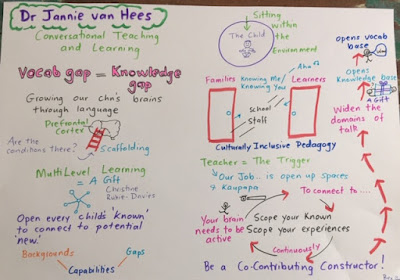Many of our learners have a vocabulary gap and as such have a knowledge gap. She talked about the benefits of multilevel learning. Also that you need to "open every child's 'known' to connect to the 'new'. This comes through carefully scaffolding by the teacher. It also develops through a process of continually scoping the known and scoping your experiences.
To learn a student's brain needs to be active. As teachers our kaupapa needs to be a co- contributor and the trigger who widens the domains of talk, opens the knowledge base and the vocabulary base.
Students need support and practice to 'TRAIN YOUR BRAIN.' Children saying 'I can't remember' can be taught to start to think again and we can help to rewire their brain. So that they respond to what others are saying and pick up the message that is shared. They need to be encouraged to 'Dig Deeper', to think and share, with no right or wrong as it's your brain and thoughts.
Dr Jannie talked about 'killing listening' and instead asking, "Did you pick up the message?" She also encouraged the idea that "Your thinking is a gift, to all of us." With this comes a culture of respect.
Play based learning was discussed as a positive thing but that we need scaffolding of talk and thinking. Don't just follow the students lead. It must be gainful for students and deliberate so that language leads to concept and knowledge gains. It is important to slow down and dig deeper. With this comes the 'Language of Abundance' which is explicit, hands on and evolves a culture of learning in an environment where you have time to dig deep. For this to happen all brains must be active and participating otherwise non learning is going on and learning time is wasted.
As you can see from my sketchnote the last section of her presentation was jam packed with ideas! She spoke about several important concepts that we can implement as co contributors and scaffolders of learning.
The first was: a 'Framework for Talk." This is when you have a class environment where it is established that everyone is a contributor. The teacher is also a contributor. If you are using a framework for talk then you set simple guidelines for the talk and then the teacher doesn't ask any questions. As a teacher this can feel difficult to do. But with lots of practice it can be done!
You also need to support students to listen to and pick up the message. Dr Jannie said her research indicated sharing with a partner was the most effective way to do this.Then they can learn to respond. It is all about valuing and including. Not questioning and 'wringing' more out of the child. At the core is the focus of children and growing their language and understanding.
At the end of her presentation Dr Jannie talked about optimising conditions for flourishing learning. There were so many points that could be broken down with students it was amazing! Here they are in bullet point format:
- Attention to and noticing
- Effort
- Triggering 'known' to connect to the 'new'
- Stretch your language repertoire
- Multiple Encounters
- Context Relevant
- Facilitate by persons, tools, tasks, activities and sources
Under the heading of Learner Attention: ( which would be brilliant as a class focus/treaty)
- Focus and notice
- Put in effort
- Take part ( participate) fully
- Push yourself to the edge
- Dig Deep for what you already know
- Learn from others- Notice and Focus
- You share, others gain from you
- Think and talk, think and read
- Wondering and asking opens up possibilities.
Whew! What an amazing presentation by an authentic, knowledgeable and engaging speaker. I am really looking forward to sharing my learning with my students and fellow teachers.
Ngā Mihi,
Bex
Bex














